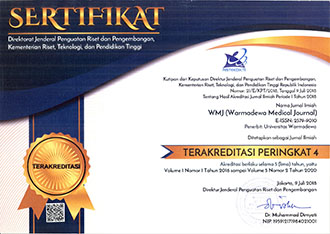Angiography Scores Can Predict Amputation in Diabetic Feet
Abstract
Diabetic foot is a complication of diabetes mellitus, with a risk of amputation. One of the risk factors for amputation is peripheral arterial occlusive disease. Angiography is a diagnostic method used to visualize blood vessels, plan therapeutic actions, and predict prognosis, including the likelihood of amputation. The validity of angiography scores in predicting amputation in diabetic foot patients is assessed. This study is a diagnostic test to determine the validity of angiography scores in predicting amputation in 23 diabetic foot patients at Prof. Dr. I.G.N.G. Ngoerah General Hospital. Data analysis used the Receiver Operator Curve (ROC) and diagnostic tests to obtain the Area Under the Curve (AUC), cutoff point, sensitivity and specificity, Negative Predictive Value (NPV), Positive Predictive Value (PPV), Positive Likelihood Ratio (PLR), and Negative Likelihood Ratio (NLR). The study results showed a cutoff point for angiography scores of 33% with an AUC of 0.9841 (>0.7) for the percent score and a cutoff point of 6 with an AUC of 0.9960 for the total score (>0.7). The sensitivity and specificity of the angiography scores were very good for predicting amputation in diabetic foot, at 92.9% and 88.9% (CI 95%), respectively. With PPV of 92.9% and NPV of 88.9%, the diagnostic value of angiography scores in predicting amputation in diabetic foot patients is supported. This study shows that angiography scores have good validity in predicting amputation in diabetic foot patients.
 Abstract viewed = 13 times
Abstract viewed = 13 times
 PDF downloaded = 6 times
PDF downloaded = 6 times





